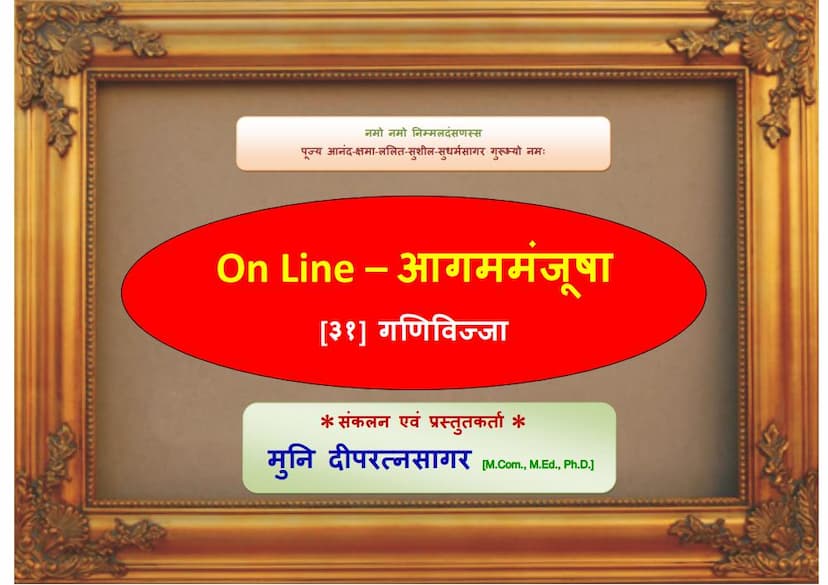Aagam Manjusha 31 Painnagsuttam Mool 08 Ganivijja
Added to library: September 1, 2025

Summary
Here's a comprehensive summary of the Jain text "Aagam Manjusha 31 Painnagsuttam Mool 08 Ganivijja," based on the provided pages:
Title: Aagam Manjusha 31 Painnagsuttam Mool 08 Ganivijja (Part of the Agam Manjusha series, focusing on the Ganividya Painna)
Authors/Editors: Anandsagarsuri, Sagaranandsuri (original editors), Munishri Deepratnasagar (compiler and presenter of this online version)
Publisher: Deepratnasagar
Core Subject: The text is primarily concerned with Ganividya, which translates to "knowledge of the Ganis" or, more broadly, the principles and auspicious timings for various activities and journeys, often related to the conduct of monks and laypeople within the Jain tradition. It draws heavily on astrological and omens-based knowledge (nimitta).
Introduction and Context:
- Historical Significance: The "Aagam Manjusha" was originally compiled approximately 70 years prior to the online publication, in 1942, by Acharya Shri Anand Sagar Suriji. This new online edition is presented in 2012 by Munishri Deepratnasagar.
- Evolution of the Edition: The compiler, Munishri Deepratnasagar, notes some variations in this edition compared to the original "Aagam Manjusha." These include the inclusion of commentaries (Yukti, Bhashya) along with the core sutras in texts like Avashyak Sutra and Jitkalpa Sutra. Alternative texts like Panchakalpa and Pindaniryukti are also incorporated, with some changes in their printing locations.
- Purpose: The online presentation aims to make this valuable Jain knowledge accessible to a wider audience through the internet.
Key Themes and Content of Ganividya:
The core of the text delves into the auspiciousness and inauspiciousness of various times, days, constellations (nakshatras), and celestial influences for undertaking specific actions. This is often referred to as "Balaabal Vidhi" (the science of strengths and weaknesses) and "Navpal Vidhi" (nine-fold rules). The text outlines how to determine the suitability of different periods for significant events.
Specific Content Areas and Examples:
-
Days and Time Cycles:
- The text discusses the auspiciousness of specific days of the lunar fortnight (tithi) and their impact on outcomes. For example, certain tithis are described as auspicious for initiating activities, while others might indicate obstacles.
- It analyzes the influence of the sun and moon, suggesting favorable and unfavorable periods based on their positions and movements.
- Examples: Specific tithis like Pratipada, Panchami, and Dashami are mentioned with their associated auspiciousness. Certain tithis are to be avoided for specific actions.
-
Constellations (Nakshatras):
- A significant portion is dedicated to the role of constellations in determining auspicious times.
- The text identifies specific constellations that are considered favorable for starting journeys (gamanas), establishing oneself, and performing specific types of spiritual practices.
- It also mentions constellations that are to be avoided for certain actions.
- Examples: Ashwini, Bharani, Krittika, Rohini, Mrigashirsha, Punarvasu, Pushya, Hasta, Chitra, Swati, Vishakha, Anuradha, Jyeshtha, Mula, Purvashada, Uttarashada, Shravana, Dhanishtha, Shatabhisha, Purva Bhadrapada, Uttara Bhadrapada, Revati are all discussed in relation to auspicious timings for different activities. Specific combinations of constellations are highlighted for their positive or negative implications.
-
Planetary Influences (Graha):
- The text examines the impact of planetary positions, including Rahu and Ketu, on the auspiciousness of times.
- It discusses how certain planetary conjunctions or influences can create unfavorable periods, leading to obstacles or negative outcomes.
- Examples: Positions of planets like the Sun, Moon, and others in specific constellations or at particular times are analyzed. The influence of Rahu-graha, Ketu-graha, and other "Kura-graha" (malefic planets) are considered.
-
Omens (Nimitta):
- The text places a strong emphasis on understanding and interpreting omens (nimitta) as a crucial factor in determining auspicious times and avoiding inauspicious ones.
- It suggests that proper observation and understanding of omens can help in making correct decisions regarding activities.
- Examples: The text mentions "Shakun" (omens) and "Laavala" (omens/signs) as important indicators. It distinguishes between auspicious, inauspicious, and neutral omens. The interpretation of "Shakun" in relation to celestial bodies (graha) is also detailed.
-
Specific Activities and Practices:
- The "Ganividya" provides guidelines for various activities undertaken by monks (Sadhu/Sadhavi) and potentially laypeople.
- Examples:
- Nishkramana (Departure/Beginning a Journey): Detailed rules are given for starting a journey, considering tithis, nakshatras, and planetary influences.
- Svadhyaya (Study): Specific timings are recommended for studying scriptures.
- Anasana (Fasting) and Tapasya (Austerities): Auspicious periods are suggested for undertaking these spiritual practices.
- Gana Sangraha (Collecting disciples/followers) and Gana Sthapana (Establishing a spiritual order/leader): Guidelines for these are also present.
- Upakaran (Equipment) and Vastra (Clothes): Advice on the timing for obtaining and preparing such items is included.
- Seva (Service): The text touches upon performing service to gurus and deities at appropriate times.
-
Classification of Omens:
- The text categorizes omens based on their nature, such as auspicious (prasasta), inauspicious (aprasasta), strong (balavanta), and weak (shithila).
- It advises to undertake actions during auspicious omens and avoid them during inauspicious ones.
Underlying Philosophy:
The text reflects the Jain belief in Karma and the interconnectedness of actions, celestial influences, and spiritual progress. By understanding and adhering to these guidelines, individuals aim to minimize obstacles, maximize positive outcomes, and progress on the path of spiritual liberation. The emphasis on "anuyoga" (application of knowledge) and "praman" (valid evidence) highlights a systematic approach to understanding these principles.
Overall Message:
"Ganividya" within the "Aagam Manjusha" serves as a practical guide for living a life aligned with Jain principles, emphasizing the importance of timing and celestial influences in various activities. It provides a framework for making informed decisions that support spiritual growth and well-being by understanding the subtle interplay of various cosmic forces as interpreted through ancient Jain knowledge. The online accessibility of this edition signifies a commitment to preserving and disseminating this valuable heritage.